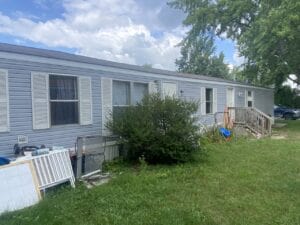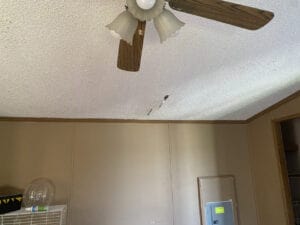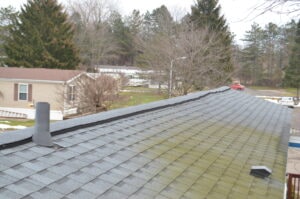If you live in an area that has trees over your home, you may experience a mold roof. What exactly is a mold roof? It appears as a green blackish moss on the roof, and it starts out slowly and then spreads quickly across the shingles. This can really make your roof look bad, and it can cause other issues if left untreated.
Mold on a Roof: Top Ways to Fix It
In this article we will cover ideas to keep your roof looking in tip top shape and looking its best.
Causes of a Mold Roof
There are many reasons that a roof can start to grow mold. Poor ventilation, high humidity, water damage, lack of maintenance, all these can play a part.
Mobile home maintenance is important and can catch many issues before they turn into something bigger.
Look around your mobile home and see if you have any trees that are draping over the home. If you can cut them back so the sun can get onto the roof this will help. Once you have the cause of the issue simply treat your roof and then the sun should be able to do the rest.

Effects of Mold on Roofs
Mold on the surface of your shingles can have a negative effect if not addressed quickly. This greenish black substance can cause discoloration, degradation and staining that can be very difficult to remove if left untreated. You might be surprised to learn that this can lead to leaks and to structural damage.
Health Effects
Mold is not healthy for anyone. Even if you feel that you are not affected by it. It can cause issues later down the road. If it is inhaled it can cause major issues, especially for people with allergies or weakened immune systems. There are steps you can take to make sure you don’t end up with mold on your roof.
Structural Damage
Just looking at mold on your roof you wouldn’t think that it could do any type of damage other than just looking bad. However, mold will slowly chip away at the edges of your shingles. This can lead to small holes in your shingles where water can start to seep in. Mold can also cause warping and buckling of roofs over time. If left untreated for long periods of time the mold will get past the shingles onto the plywood on your roof and then down into the insulation and this is where the big trouble can start. It’s important to get this issue resolved as soon as possible to avoid further damage.
Another important thing to keep clean are you mobile home gutters. These can have big effects on your roof.

Financial Costs
The financial costs really depend on how long the mold has been on your roof and how severe the issue is. If you have just noticed the mold treating the situation should easily cost you under $100. This also depends on whether you make your own mixture to treat the situation of if you are going to purchase a ready to go option.
Another factor that will come into the cost of treating the mold roof is whether you are able to climb up on the roof and treat the problem yourself. If you have to hire someone to do the job this could double or triple the costs involved.
Make sure if you do hire someone to do the job you hire a professional that is licensed. Having someone come bouncing off your roof would be super expensive and that is something your insurance company would not like.
How to Remove Mold from Roof
When it comes to removing the mold from your roof, safety is the first step. You will want to get a ladder and hop up on the roof. Make sure before you venture onto the roof that you have safety materials on such as gloves, masks, and eye protection. Once mold is scattered into the air its small particles can get into very tiny places.

How to Remove Mold from a Roof Shingles
Your first step will be to remove any debris and sweep the roof surface to prepare it for treatment. The best treatment to remove mold is a mixture of bleach and water typically a 1 to 3 ratio.
Roof Mold Remover & Cleaner
There are also many mold mixtures that you can pick up from your local hardware store as well. Use a stiff type of brush to scrub the mixture into the shingles making sure not to be too rough to damage the shingles. Use water to rinse the shingles and flush away the mold debris.
One of the best commercial mold products is Wet & Forget.
Tip: Removing the mold on a nice sunny day will help the mixture to activate and it will aid in the results of removing the mold quickly.

If you like this article and you also have mold on your siding check out our article called Siding Mildew
Mold on a Roof: Conclusion
In conclusion mold on your roof is best if treated right away. You want to do your best not to damage the shingles when removing the mold. Staying ahead of the problem and treating the roof for future breakouts should keep you ahead of the game.
FAQ’s: Mold on a Roof
Is mold on the roof a problem?
Mold on the roof can be a problem as it can lead to structural damage and health concerns if left unaddressed. It’s essential to treat and prevent mold growth.
How do you treat mold on a roof?
To treat mold on a roof, you can use a mixture of water and detergent to scrub the affected areas, followed by thorough rinsing. Preventive measures like proper ventilation and maintaining a clean roof can also help deter future mold growth.
Do roofers remove mold?
Some roofers may offer mold removal services, but it’s not always their primary expertise. You may need to hire a specialist in mold remediation for severe cases.
Is green mold on a roof bad?
Green mold on a roof is a sign of organic growth, which can cause damage over time if not addressed. It’s important to take steps to remove and prevent its return to maintain the roof’s integrity.
